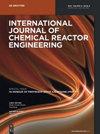Numerical analysis of various shapes of lozenge pin-fins in microchannel heat sink
IF 1.6
4区 工程技术
Q3 Chemical Engineering
International Journal of Chemical Reactor Engineering
Pub Date : 2023-09-11
DOI:10.1515/ijcre-2023-0092
引用次数: 1
Abstract
Abstract Higher density heat flux is the major cause of damage to the electronic component; therefore, cooling such components are of the utmost importance to operate in a safe zone and to increase their life. For this purpose, Microchannel heat sinks (MHSs) are among the most practical methods for dissipating unwanted heat. In this regard, the novel lozenge-shaped pin-fins in the flow passage of the microchannel heat sink (MHS) have been designed and proposed to achieve higher cooling performance. Aspect ratios (λ = 0.30, 0.39, 0.52, 0.69, 1.00) of several lozenge-shaped pin-fins have been used into the design of MHS to investigate their impact on heat transmission and fluid flow characteristics. A three-dimensional model of MHS with a lozenge-shaped has been generated and simulated numerically in the following range of Reynolds numbers, starting from 100 to 900. Heat transmission and flow characteristics have been presented and discussed in detail. It has been found that introducing lozenge-shaped pin-fins in MHS has greatly improved cooling performance. The highest improvement in Nusselt number has been observed when aspect ratio (λ) of lozenge-shaped pin-fins was 1.00. The Nusselt number have been varied in the following ranges of 6.96–12.34, 6.97–12.72, 7.01–13.62, 7.09–14.43, and 7.12–15.26 at λ = 0.30, λ = 0.39, λ = 0.52, λ = 0.69, and λ = 1.0, respectively. In addition, a study of the thermohydraulic performance of the proposed lozenge-shaped pin-fins in the MHS found that this design is an effective means of lowering operating temperature.微通道散热器中不同形状菱形针翅的数值分析
摘要高密度热通量是造成电子元器件损坏的主要原因;因此,冷却这些部件对于在安全区域内运行和延长其寿命至关重要。为此,微通道散热器(MHS)是最实用的散热方法之一。在这方面,为了实现更高的冷却性能,已经设计并提出了微通道散热器(MHS)流道中的新型菱形销片。在MHS的设计中,使用了几种菱形销翅片的纵横比(λ=0.30、0.39、0.52、0.69、1.00),以研究它们对传热和流体流动特性的影响。已经生成了菱形MHS的三维模型,并在以下雷诺数范围内(从100到900)进行了数值模拟。详细介绍和讨论了热传递和流动特性。研究发现,在MHS中引入菱形销翅片大大提高了冷却性能。当菱形针状翅片的长宽比(λ)为1.00时,观察到努塞尔数的最高改善。在λ=0.30、λ=0.39、λ=0.52、λ=0.69和λ=1.0时,努塞尔数的变化范围分别为6.96–12.34、6.97–12.72、7.01–13.62、7.09–14.43和7.12–15.26。此外,对MHS中所提出的菱形销翅片的热工水力性能的研究发现,这种设计是降低工作温度的有效手段。
本文章由计算机程序翻译,如有差异,请以英文原文为准。
求助全文
约1分钟内获得全文
求助全文
来源期刊
CiteScore
2.80
自引率
12.50%
发文量
107
审稿时长
3 months
期刊介绍:
The International Journal of Chemical Reactor Engineering covers the broad fields of theoretical and applied reactor engineering. The IJCRE covers topics drawn from the substantial areas of overlap between catalysis, reaction and reactor engineering. The journal is presently edited by Hugo de Lasa and Charles Xu, counting with an impressive list of Editorial Board leading specialists in chemical reactor engineering. Authors include notable international professors and R&D industry leaders.

 求助内容:
求助内容: 应助结果提醒方式:
应助结果提醒方式:


